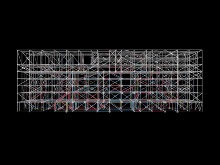ADAPTATION AGENCY
Development of agent-based design methods for the architectural design and future reconfiguration of adaptive structures
Load-bearing structures are typically dimensioned for critical yet infrequent loads. Therefore, much of the construction material used remains underutilized during most of a building’s service life. Contrary to the mere reliance upon material, adaptive structures utilize sensor-actuator mechanisms to detect and actively manipulate, i.e., homogenize, forces and deformations resulting from adverse loads. This allows for material savings of around 50% and a doubling in service life compared to optimized passive structures.
The development of adaptive structures, however, presents an interdisciplinary and multifaceted design challenge that goes beyond the mere equipment of structures with sensors and actuators. Above all, the prerequisite for a structure to effectively manipulate forces and deformations is a high degree of adaptability. In the case of adaptive truss structures, adaptability directly relates to truss topology. Previous research indicates that existing structural typologies exhibit only limited adaptability. Design methods, experience and intuition established for conventional structures can therefore not be transferred to that of adaptive structures. This, in turn, calls for adaptivity-specific design methods that compensate for the lack of experience and intuition and enable designers to explore genuinely adaptable structural topologies beyond existing typologies.
Aim and Research Questions
This doctoral research investigates the design of adaptive structures from the perspective of architecture. The aim is to facilitate the ‘designability’ of structural adaptation to ensure its accessibility for architectural practice and, consequently, its dissemination as a low-emission building technology. This challenge will be investigated with respect to the initial design as well as the future re-design of adaptive structures, as specified by the following research questions:
- What computational methods and tools are necessary to support architects in the explorative design of adaptive buildings so that complex and non-intuitive adaptivity-specific requirements can be incorporated, from the outset of a design process, with utmost creativity and agency?
- How can the methods and tools developed facilitate the re-design of future adaptive building stock so that the adaptation of forces and deformations does not compromise the structural and architectural reconfiguration in response to ever-changing programmatic and socio-economic demands?
Expected Contributions
The expected contributions of this dissertation are threefold, as it addresses the agency of future adaptive structures, through the integration of associated design objectives into early architectural design processes. Second, it addresses architects, by providing them with the means necessary to design adaptive structures and thus to unfold their design agency. Third, it addresses the agency of future inhabitants and owners of adaptive structures by facilitating not only the adaptation of structural performances but also that of architectural spaces in response to changing programmatic and socio-economic demands.
PROJECT TEAM
ICD Institute for Computational Design and Construction, University of Stuttgart
Mathias Maierhofer, Prof. A. Menges
PROJECT FUNDING
DFG – Collaborative Research Center 1244, Project A02
RELATED PUBLICATIONS
Forthcoming
Contact Information

Mathias Maierhofer
M.Sc.Research Associate


